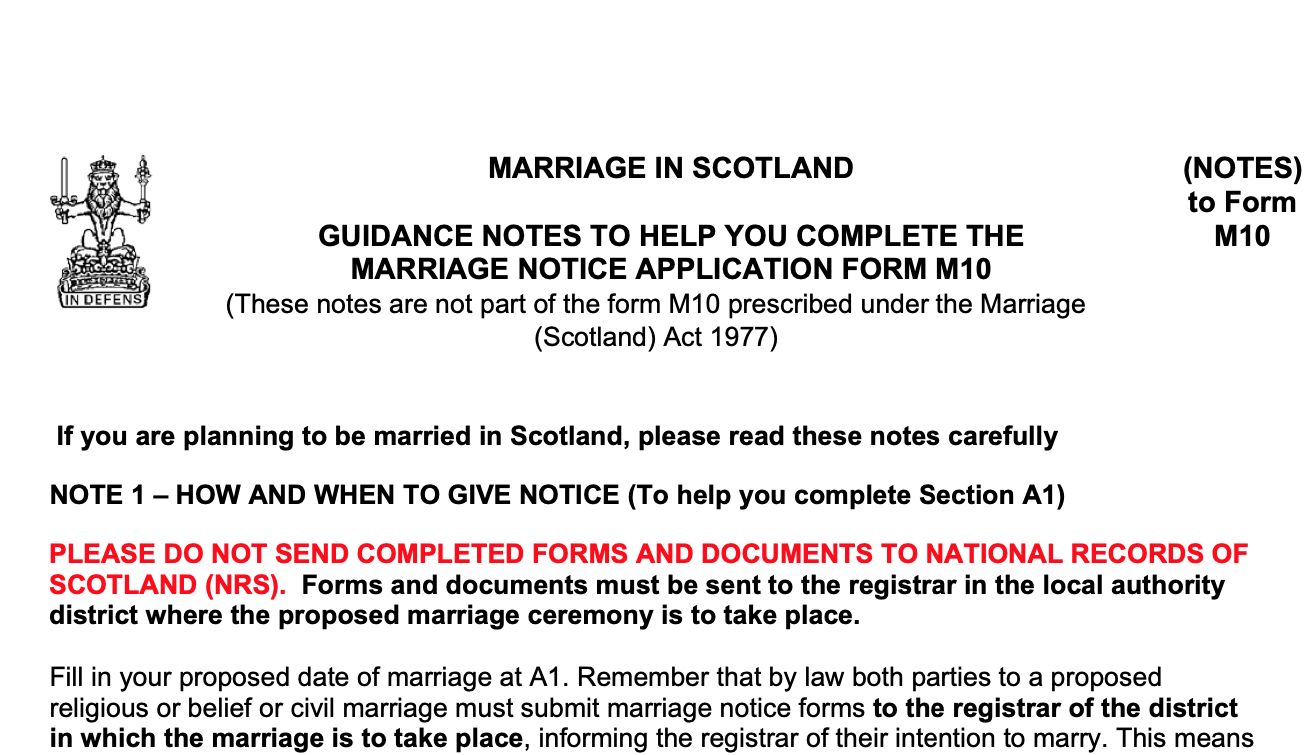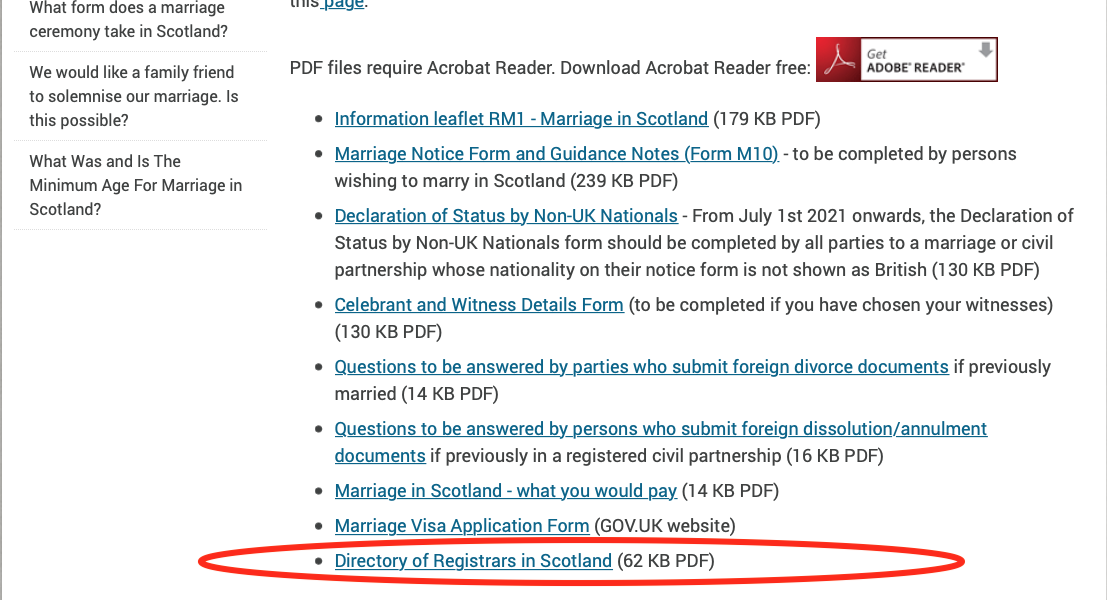With the rise in popularity of humanist weddings in Scotland, more and more people are choosing to come from all around the world to marry here, which is great news, but every so often someone asks this question:
‘…is a humanist wedding legally binding in England?’
Here’s the definitive answer.
A humanist wedding conducted in England is not a legal ceremony.
What do we need to do about the legal procedures?
Two words: follow them! They’re quite straightforward, but they do need a bit of explaining, so here goes.
What does the paperwork consist of?
There are three elements that all have similar names, so to avoid confusion, let’s take them one by one.
 The Marriage Notice
The Marriage Notice
In order to be legally married, you need to obtain a Marriage Notice (M10) form. You can download an M10 form here, and you can download the guidance notes that go with it here.
You will need to submit two M10 Forms, one for each partner, so the Registrar has written proof you want to marry one other. It’s a good idea to phone the Registrar before you submit your Marriage Notices, to check their fees and to ensure you’ve got all the necessary supporting documents, including your birth certificates.
 The Marriage Schedule
The Marriage Schedule
The Marriage Schedule is the document that you, your Celebrant and your two witnesses sign on the day. It must be returned to the Registrar within three days of the wedding.
The Marriage Certificate
Your Marriage Certificate will be sent to you by the Registrar once you have returned the Marriage Schedule. This is your proof that you are legally married, so when you get it, file it somewhere safe!
When do we have to submit our paperwork?
You can’t submit the paperwork until 12 weeks before the wedding, but you can prepare the M10 forms in advance. You can collect a marriage pack from any Registrar’s Office, but it may be easier for you to download everything from the Registrar General for Scotland’s website
On that page, you’ll see a lot of links. One of the most useful is the one that gives you all the Register Offices in the country – I’ve highlighted it below.

And here are the details for all the ones in the Edinburgh area.

The guidelines suggest that you submit your Marriage Notices to the Registrar 4-6 weeks before the wedding, but it can be done 12 weeks before and I always advise couples to do it as early as possible, and in person.
If you can’t, please make sure that you’ve got the right stamp on the envelope – this may seem petty, but if you don’t, there’s a strong possibility that your letter won’t be delivered. Worse still, you won’t know that because the Registrar won’t know you’ve sent it either, so to be absolutely certain, send it by recorded delivery.
The Marriage Schedule (the document you sign on your wedding day) is usually available to collect from the Registrar during the week before the wedding and at least one of you MUST go to the Registrar’s Office to collect it in person.
In Edinburgh, the Registrar will make an appointment for you, but not all Registrar’s Offices in Scotland do, so please make a note in your diary to do this: it’s vital that you bring it on the day because without it, I cannot perform a legal marriage! So the two most important things to remember are:
Collect your Marriage Schedule from the Registrar
Bring it to the venue on the day of the wedding
The signed Marriage Schedule must be returned to the same Registrar’s Office within three days of the marriage (NB that’s three days, NOT three working days!) Anyone can do this for you, so if you’re going away on honeymoon immediately after the wedding, choose someone you can trust to do this for you. If at all possible, deliver it in person, even if you just drop it through the letterbox: that way it’s guaranteed to get there. If you have to post it, make sure that you use the right postage and to make absolutely certain, send it recorded delivery.
Some couples have asked me if they can get a copy of the signed Marriage Schedule straight away, because they need the proof in order to get an upgrade on their flight or at their honeymoon hotel. The best way to do this is to ask your venue to photocopy the signed Marriage Schedule on the day. That way you can take it on your honeymoon, but the all-important original can be delivered to the Registrar. They will then register your marriage and issue your Marriage Certificate.
Which Registrar do we submit our Marriage Notices to?
It is important to submit the paperwork to the correct Register Office and one quick phone call to them in advance will put you right. Basically, it has to be a Registrar within the Registration District where the wedding is to take place – i.e. not the one local to your home, but the one local to the wedding venue.
Registration Districts cover large areas and there may be several Registration Offices in each district. You can submit your paperwork to any one of them, as long as it is the right Registration District for the venue. You’ll find contact details for all these offices here.
Registration districts are now aligned with Local Authority areas and the main office for Edinburgh is the Registrar’s Office, Lothian Chambers, 59-63 George IV Bridge, Edinburgh EH1 1RN. You can call them on 0131 529 2600, or click here to send them an email.
For more information specifically on marrying in Edinburgh, you might want to visit the City of Edinburgh Council’s web site
Does the venue need a licence?
If you choose a Humanist wedding, the venue doesn’t need a Civil Licence as it would if a Registrar was to conduct the ceremony. This means that you can have a legal Humanist marriage ANYWHERE IN SCOTLAND without the need for the venue to be licensed in any way.
The only proviso is that the location is “safe and dignified”, so you don’t need to book a castle or even a hotel: you can have a wonderful humanist wedding in your own living room or your back garden. Other popular venues are beaches and mountains: I’ve done several, including one on Buachaille Etive Mhor in Glencoe which was pretty spectacular.
If the weather’s bad, can we postpone?
Sorry, no you can’t! The marriage MUST take place on the date and in the place detailed on the Marriage Schedule. So, if you plan to marry outdoors, you should also have a contingency plan to move indoors, and you must remember to give both locations to the Registrar when you first discuss the ceremony.
If you’re thinking of marrying on a mountain top or indeed anywhere without an indoor alternative, bear in mind Billy Connolly’s advice that “there’s no such thing as bad weather, only the wrong clothing”, and remember to tell your guests to dress appropriately!
What happens on the day?
On the day of the wedding, bring the Marriage Schedule and hand it to your celebrant before the ceremony. You need two people to witness and sign it and they can be anyone, known or unknown to you, related or unrelated, as long as they are 16 years of age or over. The Registrar may ask you for the details of the witnesses before the day of the wedding.
As part of the Humanist ceremony and in addition to whatever personal vows or promises you wish to make, you will each be asked to make a declaration to the other. This is a legal necessity and the declaration can take various forms, but is usually along the lines of repeating a statement, such as the following, after the Celebrant:
“I Mary Jane Jones / accept you Peter John Smith / in marriage” (you can additionally say “I choose/take you as my husband/wife, but the legal declaration that we use is “I accept you in marriage” because of its implicit equality).
Once you have both your declaration, the Celebrant is required to make a legal declaration to pronounce you husband and wife – a duty I consider a privilege – after which the Marriage Schedule must be signed.
What name do I use?
The bride signs in her maiden name or the name she was known by before the wedding (a previous married name for example). In other words girls, you don’t sign in your new married name (if you’re changing it of course)! The Schedule is also signed by the Celebrant and by the two witnesses.
Do we need to bring a fountain pen?
No; your Celebrant will supply it. It has to be a permanent black ink pen and if the Registrar mentions it, you can reassure them that your Celebrant has got one!
What does “transcribing your signatures” mean?
The Registrar may include an additional form with the Marriage Schedule, so that the Celebrant can transcribe your signature (ie spell out in BLOCK CAPITAL LETTERS whatever it is that you have signed), so the Registrar can decipher it.
Returning the Schedule
Once the Marriage Schedule has been signed, it must be returned to the same Registrar’s Office within three days of the wedding. If you can’t return it yourself, remember to choose someone you trust to do it for you.
Before the ceremony, the Celebrant will ask who that is and he or she will ensure that the Schedule is given into their safekeeping afterwards.
Once the Registrar has the signed Marriage Schedule, they will then prepare and send you a copy of the Marriage Certificate – and once you have the written proof that you’re legally married, all you have to do is live happily ever after!
What if we aren’t UK citizens?
The short answer is that you will need to produce additional documentation, so I would strongly advise you to phone the local Registrar to discuss this as soon as possible.
At the very least, you will need evidence of your nationality and if you are not a European (EEA) citizen, other documentation will also be required. Since the UK left the European Union, the rules have changed, but you can find a complete and printable version of the UK Government’s guidance for 2022 here.
The Scottish Government’s page is slightly more helpful. It says, “if you’re not from the UK, you need to complete and return a declaration of status’ and you can get a link to the necessary form here.
What if we have any more questions?
If you have any further questions, I recommend you call a Registrar, although you can and will find lots more useful advice on the website for the Registrar General for Scotland.
0 Comments Leave a comment